
Breast Cancer - Types, Symptoms, Causes & Treatment
Breast cancer, also known as breast cancer, is one of the most common types of cancer among women. In Romania, it causes the most deaths among all oncological diseases. According to specialist doctors, 1 in 8 women will be affected by breast cancer during their lifetime. However, the disease is not only found in women, but even in men, but much less often. The incidence ratio of female breast cancer to male breast cancer is 150:1.
What is breast cancer?
Breast cancer is caused by the uncontrolled growth and change of breast cells. Their development leads to the appearance of a tumor mass. These tumor masses first appear in the form of nodules or in the form of calcium deposits. Most of the time the nodules are benign. Unfortunately, there are cases in which they are premalignant (can develop into cancerous tumors) or even malignant.
Breast cancer can be classified into two categories:
primary
metastatic
If the malignant tumor develops only in the breast tissue, it is called primary cancer. However, like all other types of cancer , breast cancer can also attack other parts of the body. When it develops in other tissues or organs (liver, lungs, brain, etc.), it is called metastatic cancer.
If detected early, breast cancer can be treated and go into remission. That is why periodic medical examinations are very important.
Since it is one of the leading causes of death among women, it is important to be aware of the importance of breast control and regular medical examinations that can lead to early detection of breast cancer.
This article aims to present the most important information about breast cancer. Learn everything you need to know about the condition, from breast anatomy to symptoms, types of breast cancer, different risk factors, diagnosis and types of treatment.
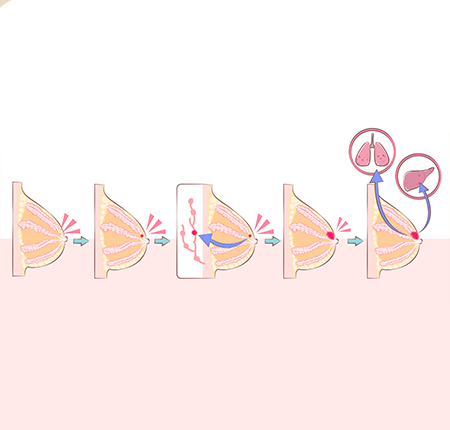
Types of breast cancer
Breast cancer can start in different areas of the breast and affect different cells in the breast. This leads to the development of different types of breast cancer. The most common types of cancer are invasive ductal carcinoma, triple negative breast cancer, and invasive lobular carcinoma.
Invasive ductal carcinoma
Invasive ductal carcinoma is the most common type of breast cancer. It occurs in 80% of breast cancer cases. Invasive ductal carcinoma first develops in the milk ducts of the breast and then spreads to the surrounding tissue, rupturing the duct tissue.
Ductal carcinoma in situ
This type of breast cancer is also known as stage 0 breast cancer. Specialist doctors consider this type of cancer "precancerous" because the cancer cells have not had time to develop outside the milk ducts. It is a treatable type of cancer most of the time. Taken early, treatment can prevent cells from spreading to other breast tissues.
Invasive lobular carcinoma
This type of cancer occurs in the lobules of the breast, where breast milk is produced. Similar to ductal carcinoma, this type of cancer also attacks the surrounding tissues. Invasive lobular carcinoma occurs in 10-15% of breast cancer cases.
Lobular carcinoma in situ
Lobular carcinoma in situ is a precancerous neoplasm. Although it is not a form of cancer itself, it is an alarm signal because it can develop into invasive lobular carcinoma. In the case of lobular carcinoma in situ, the precancerous cells are found in the lobules of the breast. With regular breast exams and mammograms, lobular carcinoma in situ can be monitored to prevent it from getting worse.
Triple negative breast cancer (TNBC)
Triple negative breast cancer accounts for 15% of breast cancer cases and is the most difficult to treat. Its name comes from the fact that this type of cancer lacks three of the tumor markers specific to breast cancer. This leads to difficult diagnosis and treatment.
Inflammatory breast cancer
Inflammatory breast cancer is one of the rarest and most aggressive types of breast cancer. It occurs when cancer cells block the skin's lymphatic vessels. As a result, the breast will show signs of inflammation, redness and swelling. Inflammatory breast cancer progresses very quickly, over several weeks or months.
Paget's disease of the breast
Paget's disease of the breast is a rare type of cancer that affects the skin of the nipple and areola. Most people diagnosed with Paget's disease also suffer from other types of breast cancer such as invasive ductal or invasive lobular carcinoma.
Breast Cancer - Signs & Symptoms
Breast cancer symptoms differ from person to person. Moreover, there is a possibility that they are not present in the early stages of the disease. However, a monthly breast self-examination can help detect abnormalities. This way you will be able to go quickly to the specialist doctor for a check-up.
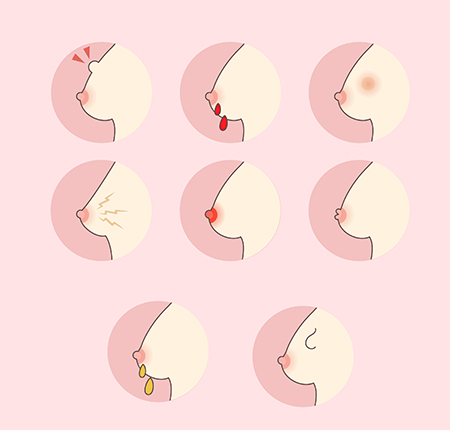
The most common signs of breast cancer are breast lumps. They can appear before or during the menstrual period, without disappearing later. Although they are not, in most cases, painful, nodules can cause a stinging sensation when palpated. Moreover, in some cases they are not visible to the naked eye, cannot be felt by palpation and can only be detected with the help of a mammogram.
Other signs and symptoms of breast cancer are:
change in breast shape and size
change in the appearance of the skin of the breast
nipple changes
retraction of the skin on certain areas of the breast
redness of the skin of the breast or nipple
unusual pain or tenderness
swelling in the armpit or collarbone area
nipple ulcerations
nipple discharge
texture of the breast similar to that of an orange peel - this is a sign of inflammatory breast cancer
the presence of a dimple or indentation on the breast
There are other non-specific signs and symptoms that may raise alarms:
weight loss
jaundice
neurological problems
joint pain
bone pain
Breast cancer stages
Breast cancer, similar to other types of oncological diseases, starts from stage 0, the easiest to treat, and can reach stage IV, the metastatic stage. Stage O breast cancer is the stage where there are cancer cells inside the breast ducts or in the lobules of the breast, but the cells have not yet attacked the surrounding tissue.
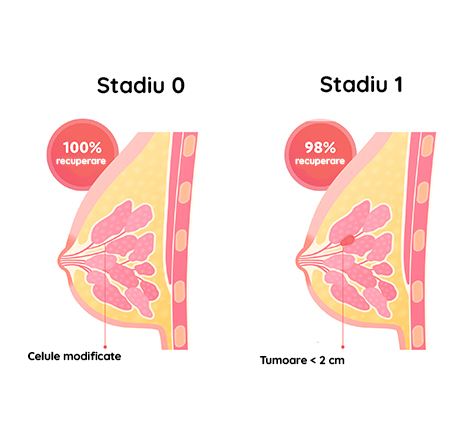
Breast cancer stage 1
Stage I is an early stage of invasive cancer. It consists of two different stages:
Stage 1A is the stage in which the tumor has a maximum width of 2 cm. The lymph nodes are not affected.
Stage 1B: the breast tumor is absent or smaller than 2cm, but there are tumor cells in nearby lymph nodes.
Stage 2 breast cancer
Stage II also consists of two substages:
Stage 2A:
the tumor is less than 2cm in size and has spread to 1-3 OR lymph nodes
the tumor is between 2-5cm, but it has not affected any lymph nodes
Stage 2B:
the tumor has dimensions between 2-5cm
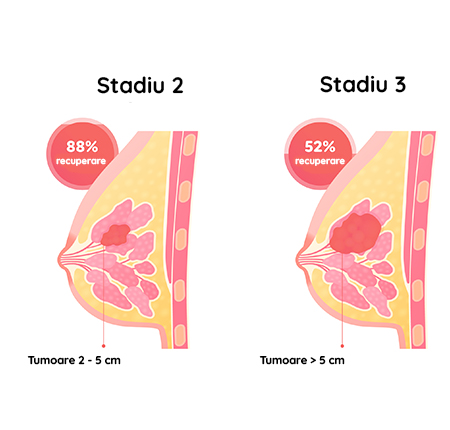
Stage 3 breast cancer
Stage III is a more advanced stage differentiated into three different stages.
Stage 3A: malignant cells have already appeared in 4-9 axillary nodes. It is also at this stage that the malignant cells migrate to the internal mammary nodes
Stage 3B: at this stage the tumor has already managed to invade the chest wall or skin, and has attacked at least 9 lymph nodes
Stage 3C: at this stage malignant cells are already present in at least 10 axillary nodes
Stage 4 breast cancer
Stage IV is the last stage of breast cancer. It indicates the presence of visceral metastases and has the lowest survival rate - 22%
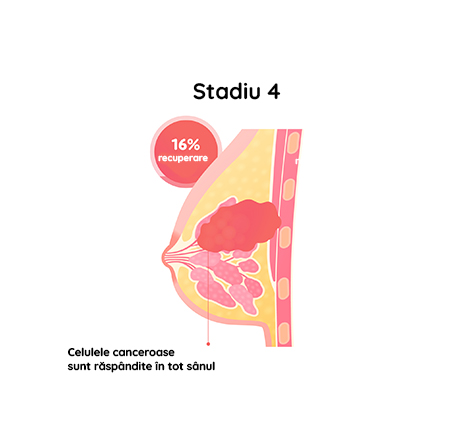
Breast cancer - Causes
Breast cancer occurs at those times when breast cells begin to develop and multiply chaotically. The exact causes of breast cancer are not known with certainty. Therefore, it is never known exactly whether or not a woman will develop breast cancer. However, researchers have identified a variety of risk factors that can increase the possibility of developing breast cancer. It is not clear why people who are not exposed to any risk factors develop breast cancer. This condition is likely to be caused by a mix of genetic and environmental factors.
Hereditary breast cancer
Hereditary breast cancer is one of the possible causes that lead to breast cancer. An estimated 5-10% of breast cancer cases are caused by genetic mutations passed down through generations. Specialists have been able to identify a number of mutated genes inherited from parents that can increase the risk of breast cancer. The most common such genes are BRCA1 and BRCA2 which increase the risk of both breast and ovarian cancer.
Breast cancer - Risk factors
A risk factor for breast cancer is anything that increases the likelihood of getting breast cancer. However, even if one or more of these factors apply to you, it does not necessarily mean that you will develop breast cancer. Many women develop breast cancer with their biological sex as the only risk factor.
In the following we present the most common causes and risk factors of breast cancer:
Sex: women are more prone to breast cancer than men
Age: older age (over 50) increases the risk of breast cancer
Previous breast conditions (eg ductal carcinoma in situ) - these conditions lead to a higher possibility of breast cancer
Previous cases of breast cancer: If you have had cancer in one breast, there is an increased risk of it developing in the other breast
Family history of breast cancer
Radiation exposure
Obesity
Onset of menstruation before the age of 12 increases the risk of breast cancer before the age of 50
Onset of menopause at an advanced age (over 55 years)
Having a first pregnancy after the age of 30 can increase the risk of breast cancer
No pregnancy - women who have never been pregnant have an increased risk of developing breast cancer
Refusal to breastfeed naturally during the first 6 months of the baby's life - breastfeeding reduces the possibility of breast cancer.
Abuse of alcohol and prohibited substances
Breast cancer prevention & diagnosis
Breast cancer prevention is not impossible regardless of the risk category you fall into. Screening is the safest and most effective method of prevention and diagnosis. However, there are a number of other steps you can take to prevent breast cancer.
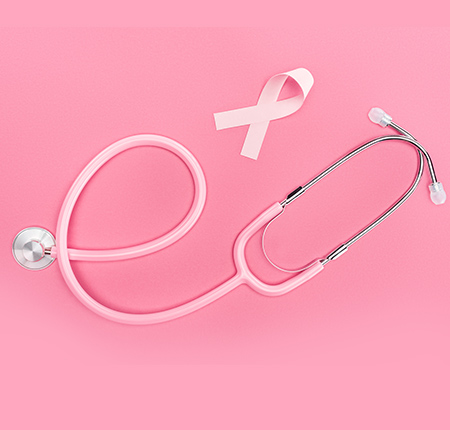
Reducing the risk of breast cancer for women in the average risk factor group
Screening. Ask your specialist doctor about screening programs, find out what their advantages are, the risks they involve and how often they should be performed.
Self-assessment. Become familiar with your breasts through self-examination. Periodic palpations can reveal warning signs such as lumps, redness, abnormal discharge or skin changes.
The alcohol. Drink alcohol sparingly or not at all
Exercise at least 30 minutes a day
Limit postmenopausal hormone therapy
Monitor your body weight
Choose a healthy diet
Reducing the risk of breast cancer for women in the high risk factor group
If your doctor has evaluated your family history and determined that there are other risk factors, such as precancerous breast disease, you can discuss options to reduce your risk, such as:
Preventive medication: Medicines that block estrogen, such as selective estrogen receptor modulators and aromatase inhibitors, reduce the risk of breast cancer in women at high risk for the disease.
Preventive surgery: Women at very high risk of breast cancer may choose to have their breasts removed (prophylactic mastectomy). They may also choose to have their healthy ovaries removed (prophylactic oophorectomy) to reduce the risk of both breast and ovarian cancer .
Bilateral breast ultrasound
Bilateral breast ultrasound is a screening test that can be used to detect breast cancer. This uses sound waves that produce images of different structures inside the body. Bilateral breast ultrasound can reveal whether a breast lump is a solid mass or just a fluid-filled breast cyst. Bilateral breast ultrasound is indicated to be performed when needed, along with digital mammography.
Digital mammography
Diagnostic digital mammography is a type of breast x-ray. This test is most often used to screen for breast cancer. If the screening mammogram reveals an abnormality, the specialist will recommend a diagnostic mammogram to evaluate the abnormality. Digital mammography is indicated to be performed once a year starting at the age of 40.
Biopsy
Biopsy, also known as ultrasound-guided biopsy puncture, is an analysis that allows the collection of a sample of breast tissue that will then be analyzed under a microscope. This analysis allows the differentiation of benign cells from malignant ones. The biopsy is the analysis that establishes the diagnosis with certainty. Moreover, it allows doctors to find out the type of cells involved and the degree of aggressiveness of the cancer.
Chances of curing breast cancer
Worldwide, more than 1.70 million new cases of breast cancer are diagnosed each year. This number represents approximately 25% of newly diagnosed cancer cases worldwide. It is estimated that approximately 500,000 people die from breast cancer annually. In Europe, the incidence rate of breast cancer is the highest in the world, and in Romania at least 7000 cases are discovered annually, of which 80% are in an advanced stage.
The chances of survival with this disease differ from person to person, depending on the stage at which the condition was discovered. Women who were diagnosed at an early stage have a much better chance of survival than those who discovered the disease at an advanced stage. However, each case is unique and the survival rate depends on elements specific to the circumstances of each condition and the characteristics of the disease.
However, breast cancer can be prevented and successfully treated with regular check-ups and self-examination. Self-palpation is the simplest and cheapest method to detect breast abnormalities, acting as a means of prevention. However, in Romania, only 1 in 10 women do this, and only 1 in 20 perform the self-examination correctly.
Breast cancer - Treatment
In cases where cancer is detected in its early stages, it can be treated before it spreads to other parts of the body. Most of the time, breast cancer treatment combines surgery, chemotherapy, and radiation therapy. The treatment plan is determined by a multidisciplinary team of doctors who will consider the type of tumor, its stage, the size of the tumor and the sensitivity of the cells. Most women through both surgery and adjuvant treatment.
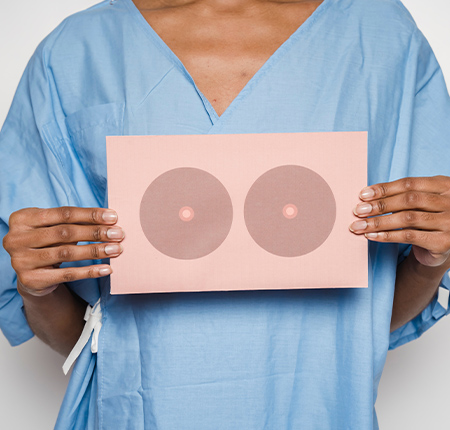
Surgical intervention
The surgical interventions used in case of breast cancer are as follows:
Lumpectomy: used for small tumors, during this operation the tumor and some of the surrounding healthy tissue is removed.
Mastectomy: in the case of mastectomy, all the breast tissue is removed. In some cases, depending on the type of tumor, the skin and the nipple are preserved to facilitate the reconstruction operation.
Removal of lymph nodes can be done in two ways
Removal of a small number of lymph nodes - sentinel node biopsy
Removal of a large number of lymph nodes - axillary lymph node dissection
Preventive mastectomy: In cases of high risk of cancer in the other breast, the patient can opt for the preventive removal of the second breast as well
Radiotherapy
Radiotherapy can be used both in early cases of breast cancer and in cases where it has spread to other tissues.
Radiotherapy can be:
Curative: to treat the cancer completely
Neo-adjuvant: used in combination with surgery or chemotherapy to increase the effectiveness of treatment
Adjuvant: to reduce the risk of breast cancer recurrence after surgery
Palliative: to reduce the intensity of symptoms, if a cure plan is not possible
Chemotherapy
Chemotherapy is sometimes needed before surgery for large tumors. The goal of chemotherapy is to shrink it to make it easier to remove. Chemotherapy is also used in cases where the cancer has spread to other parts of the body.
The most common types of chemotherapy are:
Intravenous chemotherapy
Oral chemotherapy
Hormonal treatment
Hormone therapy is actually hormone blocking therapy. This therapy uses drugs that block the effect of hormones in hormone-sensitive types of breast cancer. This therapy can be used before or after surgery.
Individual or group therapy
Complementary therapies such as group therapy, individual therapy, acupuncture, aromatherapy, and massage help patients cope psychologically and emotionally with diagnosis and treatment. These treatments can be used to reduce the stress and anxiety experienced by women with breast cancer.
What are the chances of breast cancer recurrence?
In the case of some women, breast cancer recurs after the end of treatment. This does not happen in most cases, but it is important to know the potential risk of the cancer coming back.

Although cancer recurrence can theoretically occur at any time, it usually occurs within the first 5 years after the end of treatment. The greatest risk is in the first 2 years. Cancer returns when a number of cancer cells manage to escape treatment. They can even be in small numbers; it only takes a few cells unaffected by the drugs and treatment for them to start multiplying again and attacking the tissues around them.
Recurrences occur after several years because cancer cells have the ability to remain dormant for years until a trigger occurs. Breast cancer can come back in three different ways:
locally - in the same breast
regional - in nearby lymph nodes
distant - metastases in other tissues or organs
If the cancer occurs in the other breast, but there are no cancer cells elsewhere in the body, this is a new cancer, but not a recurrence.
Frequently asked questions - Breast cancer
How long does breast cancer develop?
Breast cancer can progress differently depending on the person and the type of cancer. In some cases it evolves more slowly, over several years. In other cases, such as in the case of inflammatory breast cancer, it can progress rapidly over several weeks or months.
What blood tests are done for breast cancer?
The main blood tests recommended for the detection of breast cancer are: complete blood count, serum protein electrophoresis and the tumor marker CA 27-29 specific for breast cancer.
How do you know if you have breast cancer?
Regular physical exams, screening and annual mammograms are vital in the early detection of breast cancer. Along with these medical exams, a monthly self-examination can reveal signs and symptoms specific to breast cancer and may be a sign that you need to see your specialist for another check-up.
How much does breast cancer surgery cost?
Breast cancer surgery is settled through the insurance company in the case of public hospitals. If you want to go privately, the price of such an operation will vary depending on the number of days of hospitalization, the tests performed, the type of anesthesia used, etc.
At what age can you get breast cancer?
Breast cancer occurs in most cases in people over the age of 50. However, it can appear at any age. Almost 7% of breast cancer cases develop in people younger than 40 years old.
Can you get breast cancer while breastfeeding?
Breast cancer can occur at any time of life, including during breastfeeding. However, the risk of breast cancer during breastfeeding is much lower. For example, during a period of 5 months of breastfeeding, the risk of breast cancer decreases by 2%.
Can men get breast cancer?
Although the cases are much rarer and men can get breast cancer. The incidence ratio of breast cancer between women and men is 150:1.






















